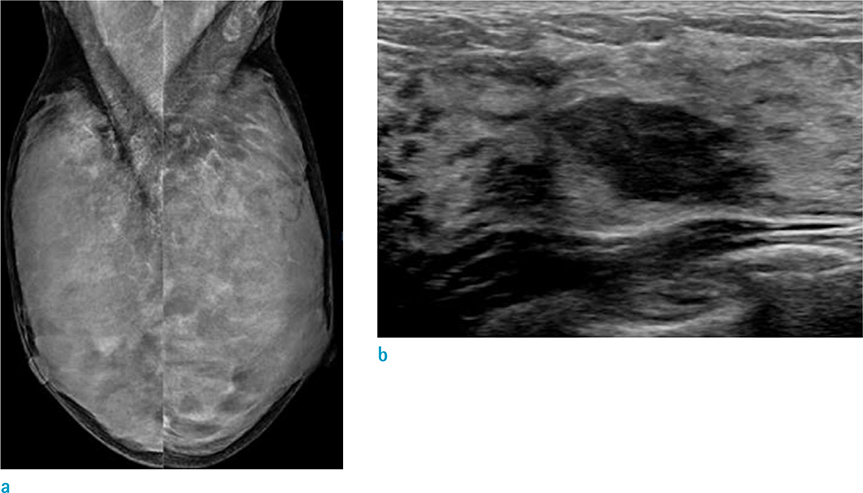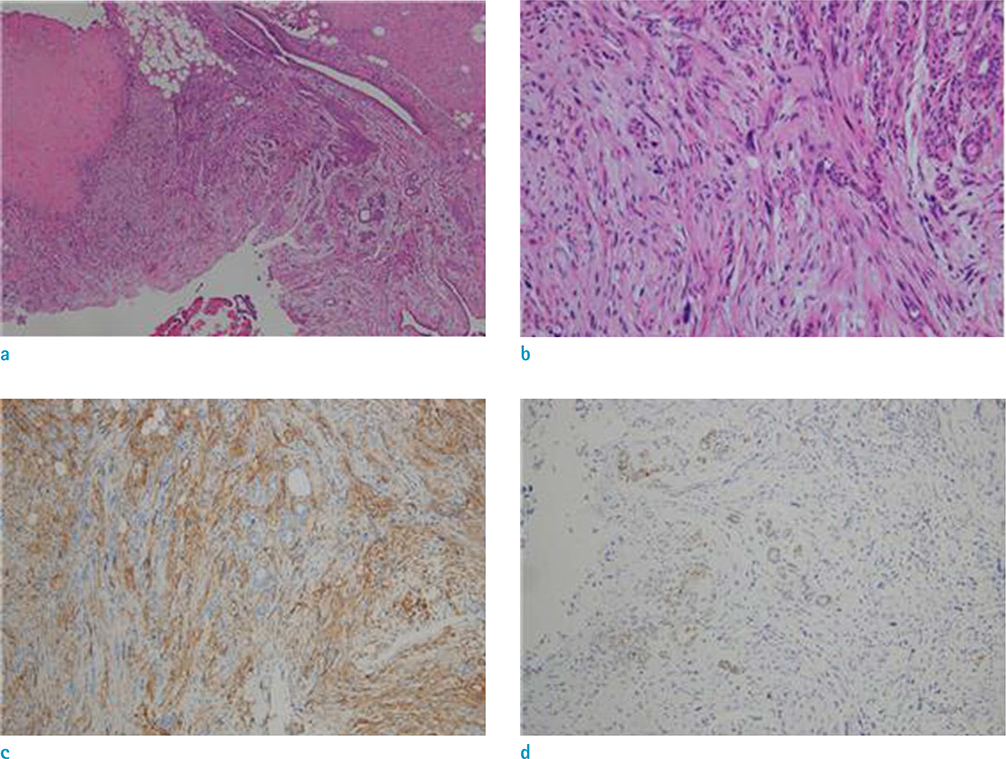Investig Magn Reson Imaging.
2017 Dec;21(4):269-272. 10.13104/imri.2017.21.4.269.
Periductal Stromal Sarcoma of the Breast: a Case Report
- Affiliations
-
- 1Department of Radiology, Dankook University Hospital, Cheonan, Korea. sirenos@hanmail.net
- KMID: 2400382
- DOI: http://doi.org/10.13104/imri.2017.21.4.269
Abstract
- Periductal stromal sarcoma (PSS) is a type of rare malignant fibroepithelial tumor. PSS is a recently introduced diagnostic entity and there are few reports about radiological features of this tumor. Pre-operative diagnosis is difficult because it reveals similar symptoms with other benign and malignant tumors with absence of specific radiologic findings. We present a woman age 30 that underwent mammotome biopsy for a BI-RADS 4 lesion on her left breast and received histopathology diagnosis of a phyllodes tumor. Additionally, she underwent a wide excision depending on her histopathology diagnosis. Her final diagnosis was PSS. Six months later, no recurrence was detected. However, frequent follow-up is needed because PSS can develop into phyllodes tumor or entity of breast cancer.
MeSH Terms
Figure
Reference
-
1. Tavassoli FA, Devilee P. Pathology and genetics tumours of the breast and female genital organs. In : Tavassoli FA, Devilee P, editors. World Health Organization classification of tumours. Lyon: IARC Press;2003. p. 101–102.2. Burga AM, Tavassoli FA. Periductal stromal tumor: a rare lesion with low-grade sarcomatous behavior. Am J Surg Pathol. 2003; 27:343–348.3. Rao AC, Geetha V, Khurana A. Periductal stromal sarcoma of breast with lipoblast-like cells: a case report with review of literature. Indian J Pathol Microbiol. 2008; 51:252–254.
Article4. Pandey M, Mathew A, Abraham EK, Rajan B. Primary sarcoma of the breast. J Surg Oncol. 2004; 87:121–125.
Article5. Callery CD, Rosen PP, Kinne DW. Sarcoma of the breast. A study of 32 patients with reappraisal of classification and therapy. Ann Surg. 1985; 201:527–553.6. Oberman HA, Nosanchuk JS, Finger JE. Periductal stromal tumors of breast with adipose metaplasia. Arch Surg. 1969; 98:384–387.
Article7. Tomas D, Jankovic D, Marusic Z, Franceschi A, Mijic A, Kruslin B. Low-grade periductal stromal sarcoma of the breast with myxoid features: Immunohistochemistry. Pathol Int. 2009; 59:588–591.
Article8. Masbah O, Lalya I, Mellas N, et al. Periductal stromal sarcoma in a child: a case report. J Med Case Rep. 2011; 5:249.
Article9. Tse GM, Tan PH, Lui PC, Putti TC. Spindle cell lesions of the breast--the pathologic differential diagnosis. Breast Cancer Res Treat. 2008; 109:199–207.
Article10. Hungermann D, Buerger H, Oehlschlegel C, Herbst H, Boecker W. Adenomyoepithelial tumours and myoepithelial carcinomas of the breast--a spectrum of monophasic and biphasic tumours dominated by immature myoepithelial cells. BMC Cancer. 2005; 5:92.
Article
- Full Text Links
- Actions
-
Cited
- CITED
-
- Close
- Share
- Similar articles
-
- Mammographic and Sonographic Findings of Periductal Mastitis: A Case Report
- Endometrial Stromal Sarcoma Presented as a Multilocular Cystic Mass without a Solid Component: A Case Report
- Two Cases of Low Grade Endometrial Stromal Sarcoma
- A Case of High-grade Endometrial Stromal Sarcoma with Metastasis to the Stomach
- A Case of Low-Grade Endometrial Stromal Sarcoma of the Uterus (So-Called ""Endolymphatic Stromal Myosis"")




